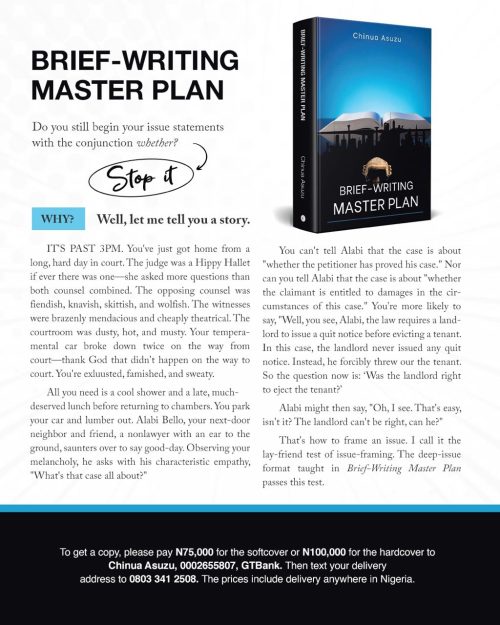ARTICLES
Graft your quotations into your text: By Chinua Asuzu

Graft your quotations into your own writing. To do this, “weave your quotation into your sentence or introduce it with a lead-in or, better, an upshot. These introductions will assure that your reader reads your quotation.” Gerald Lebovits.
A lead-in introduces the reader to the quotation. Outgrow stereotyped, bare lead-ins like these:
· As Oputa JSC stated, “…”
· The statute provides, “…”
· The Supreme Court held, “…”
· According to Ben Nwabueze, “…”
Prefer informative lead-ins, especially when introducing block quotations. Tailor your lead-in to the quotation. “Say something specific. Assert something. Then let the quotation support what you’ve said.” Bryan A. Garner. Especially but not exclusively with block and long quotations, “evoke the gist of the quotation in the lead-in,” like these:

· Oputa JSC restated the 4 criteria an applicant must meet for the grant of an interlocutory injunction: “…”
· The statute restricts relief to contexts in which the petitioner has supplied proof of consistent use: “…”
· The Supreme Court pointed out the exceptions to the no-liability-without-damage rule: “…”
· Ben Nwabueze argues that Nigeria’s constitutional bill of rights incorporates freedom of private enterprise: “…”
Lead-ins like these show that you understand the authority you’re about to quote. It shows professional responsibility, diligence, and respect for the reader. It’s also a smart rhetorical device. “[T]he lead-in becomes an assertion, and the quotation becomes the support.” Garner. In your lead-in, don’t exaggerate or mischaracterize the forthcoming quote, as that would earn you a backlash from the reader who’ll then view you with suspicion.
Chinua Asuzu, Brief-Writing Master Plan (Partridge, 2022), 469–470.


Click Button Below to Join Our Telegram Groups

For Advert Inquiries & News/Article Publishing
Call:+2348033888791, +2347069999005
E-mail: legalattorneyblog01@gmail.com









